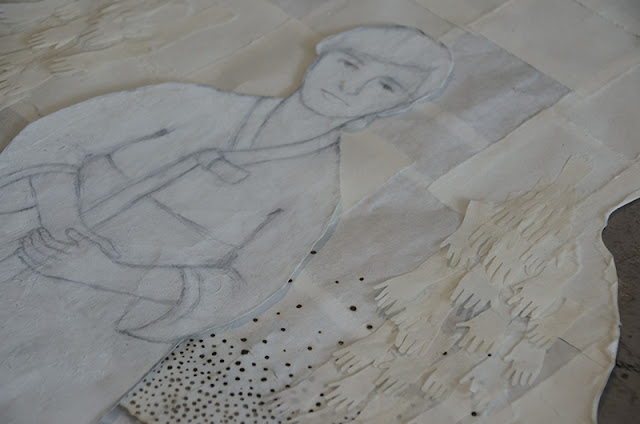From the top: diagram for an installation as I could not go to Korea to do so.
Production in progress in March and in July 2020. It took 6 months to complete.
Details of Peace River
Lightful Peninsula ( a smaller work)
A detail shot of the smaller Korean Peninsula, "Lightful Peninsula" has 5 bridges on it. Each bridge was drawn by my Korean friends in Korea and in Vancouver, printed out on Korean paper in small scale, and was laminated onto the map around the "38". Bridges for a symbol of the ultimate reunification.
Bak, Sosan
Choi, Sinae
Goo, Sooyeon
Lee, Myoung Jae
Pheon, Solan
Goo, Sooyeon
I attach my artist note below: Artist Notes on Ms. Yoonmi Jeon and the work.
_______________________________________
Artist Notes on Ms. Yoonmi Jeon and the work.
Title: Peace River – Bridge – Reaching out hands
Tributes to (Ms) Yoomi Jeon (and prayers to peace and reunification in the Korean Peninsula.)
In the spring of 2020, Ms. Youngme Moon, the chief curator at Lee Hanyeol Memori-al Museum, sent me the following description, “The person about whom you are making art is Ms. Jung Yoomi, a Korean American, who devoted her life to bringing peace to the Korean Peninsula by bridging the gap between South and North Korea”.
In addition, I obtained photos and write ups from Ms. Moon and Mr. Ik Tae Kim (Ms. Jung’s friend) and a speech by Mr. Klein, Ms. Jeon’s partner. For almost 6 months, I lived closely with these photos and writings in my studio and from this experience I grew to feel that she was an open, warm hearted, passionate woman who was both empathetic and compassionate and possessed a strong sense of justice and a will-ingness to stand up for injustice.
Because of the pandemic and the lock down, I spent time by myself reading about her and imagining her nature and life, and studying about Korean War in depth.
To understand her life was to understand the Korean War and the Japanese occupa-tion of the Korean Peninsula in 1910 and all of the pain that the Korean people went through. It was brutal and merciless. While reading and talking with Korean friends about the Japanese occupation and the Korean war, I became sorrowful and heavy hearted with a strong sense of guilt about what my mother land had done to the people and land of the Korean Peninsula. Often I could not stop sobbing. It was a difficult process emotionally, mentally and physically to make art about her life of activism for her people and country because it was a tragedy caused by my country.
While contemplating how to represent her life and the theme of peace and reunifi-cation into a work of art and out of feeling such pain, the colour of white and a map of Korea as Jogappo and bridges transpired.
White to me is the colour of peace. Also, I read more than once, that Korean people are known to love the colour of white. Since I was young I have loved Jogappo, a traditional Korean patchwork, created by a member in each family as a pure art form and a symbol of everyday living. Making a map of the Korean Peninsula in the same manner as a Jogappo felt like a symbol of unity of many lives. Bridges came to mind as they can bring people on two sides together.
My initial vision was to have the Korean Peninsula, her portrait in Hanbok and her holding small bridges in her hands.
Later hands became an important symbol because of a Korean friend’s words. He expressed to me, “ What we need more is to touch (embrace) each other and hold each other’s hands, more than bridges.” I never forgot his face when he expressed his feelings so in end I added many cut out hands that reach out from south and north Korea to touch each other in the river.
Lastly a river of white waves, came to me after my Japanese friend introduced me to a song called “Imjin River” sung in both in Hanguel and Japanese. This song was about yearning for reuniting with loved one, wishing their dreams to the Imjin River of clear water.






